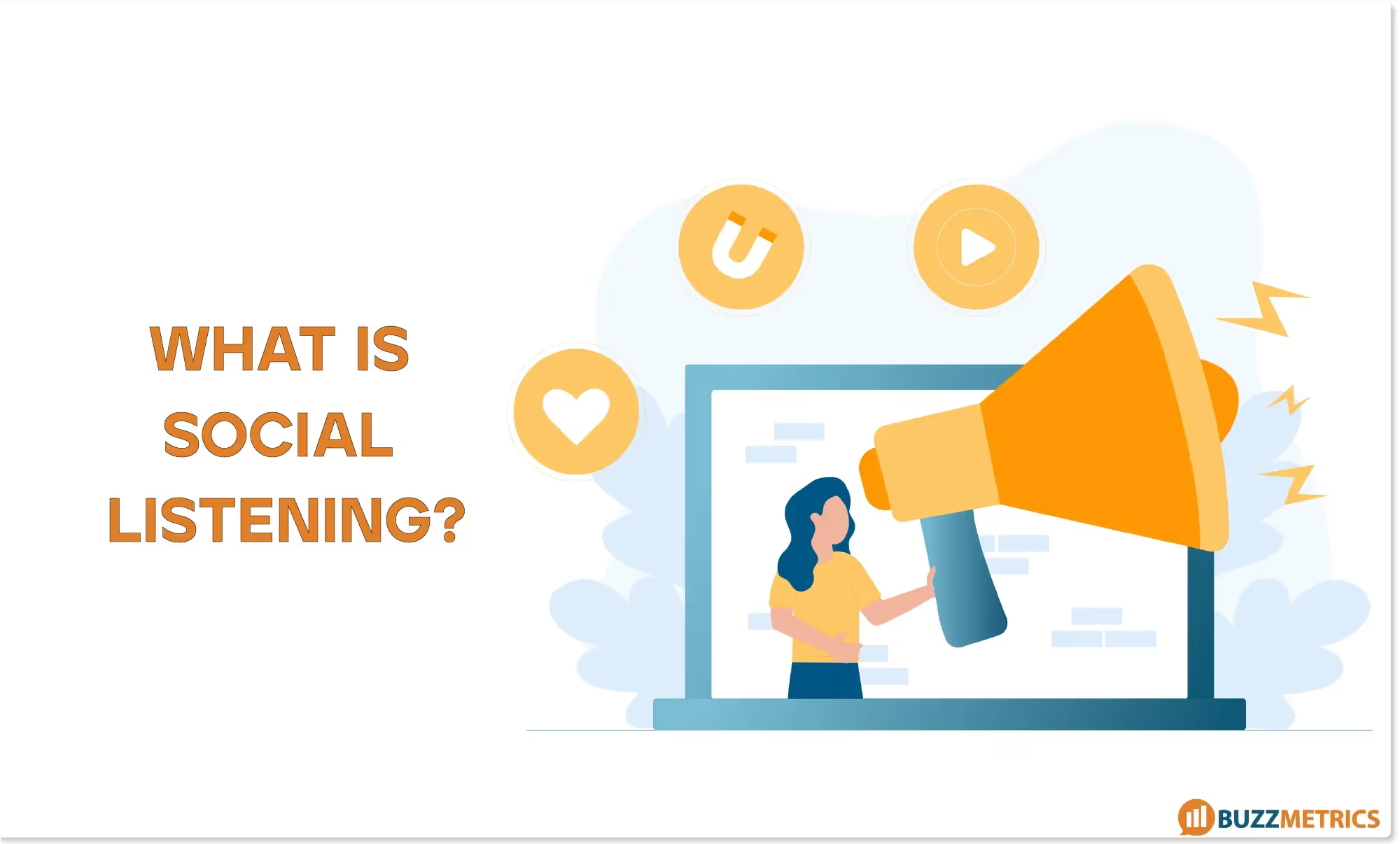
Social Listening is a form of market research based on social media discussions, helping to analyze brand health, campaigns, special events, and more...
Along with the development of social networks, Social Listening is also growing in application capabilities. If in the past, Social Listening was only about collecting social media data, today data collection is only a part of Social Listening. Measuring buzz volume or sentiment is no longer the only function of Social Listening. In the context of this article, let's look at old questions through a new lens: What is social listening and what role does it play in social media marketing?
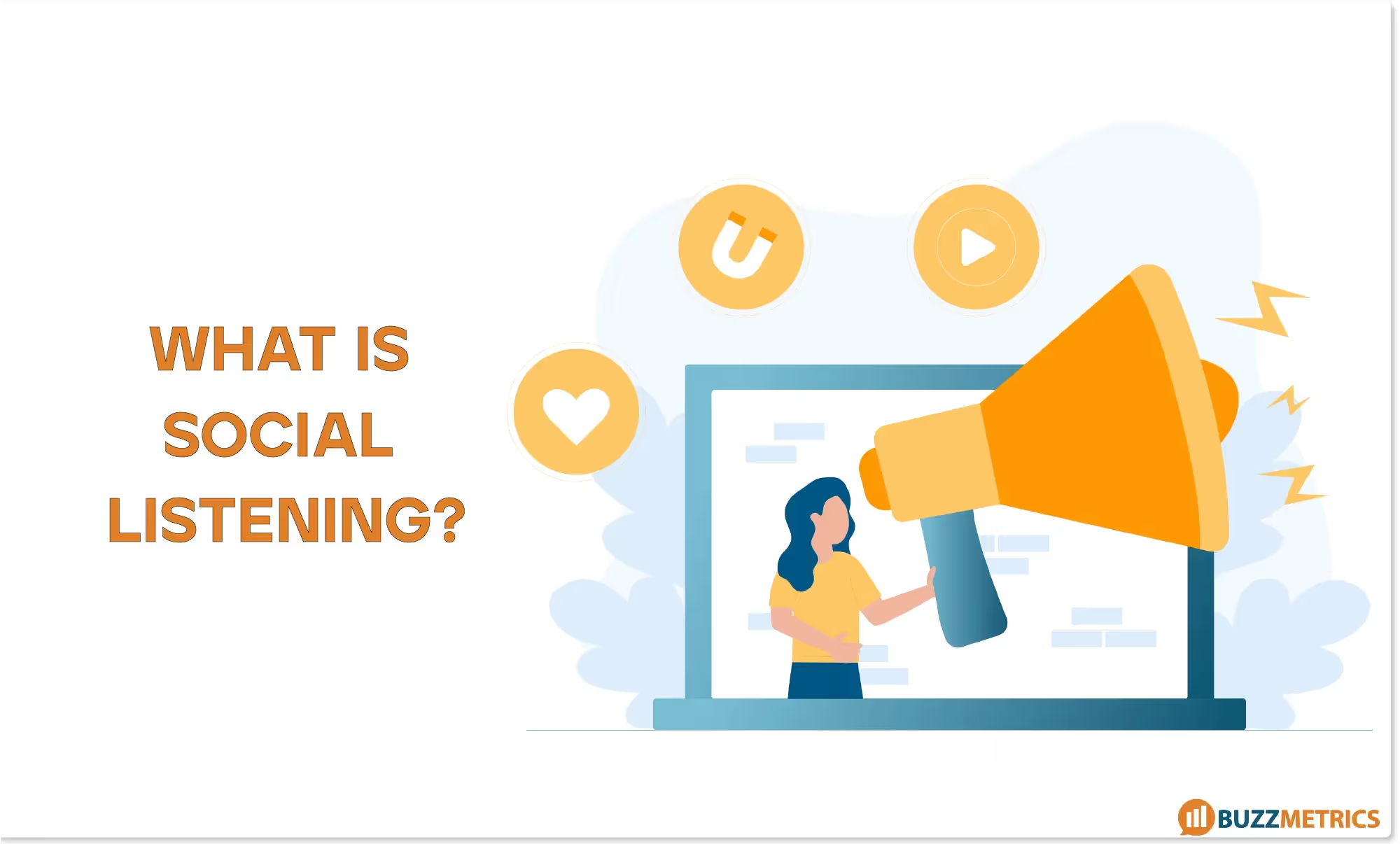
Social Listening is a form of market research that analyzes online user discussions across social media platforms. It involves the collection and analysis of conversations from various online platforms, including social media, forums, blogs, news sites, and review websites. Unlike traditional research methods, Social Listening works primarily with unstructured data, offering businesses real-time feedback from diverse users across different online platforms.
Typically, a Social Listening process follows these steps:
- Step 1: Build an analysis plan
Researchers begin by defining the context and research objectives, then set the key questions to be addressed.
- Step 2: Data collection
Using Social Listening tools, researchers gather data based on keywords from all social platforms, ensuring an accurate and comprehensive understanding of trends and industry data.
- Step 3: Data filtering and analysis
After collecting data, researchers filter out irrelevant or misleading information to ensure accuracy. Data is processed through AI systems and human verification to find potential insights.
- Step 4: Data visualization and reporting
Finally, the results are compiled into a complete report with visualized data for easier understanding and decision-making.
Social Listening data sources are not limited to major social media platforms like Facebook, Instagram, TikTok, or Threads. They also cover any medium that allows multi-way interaction, including forums, e-newspapers (comment sections), blogs, and e-commerce review sections.
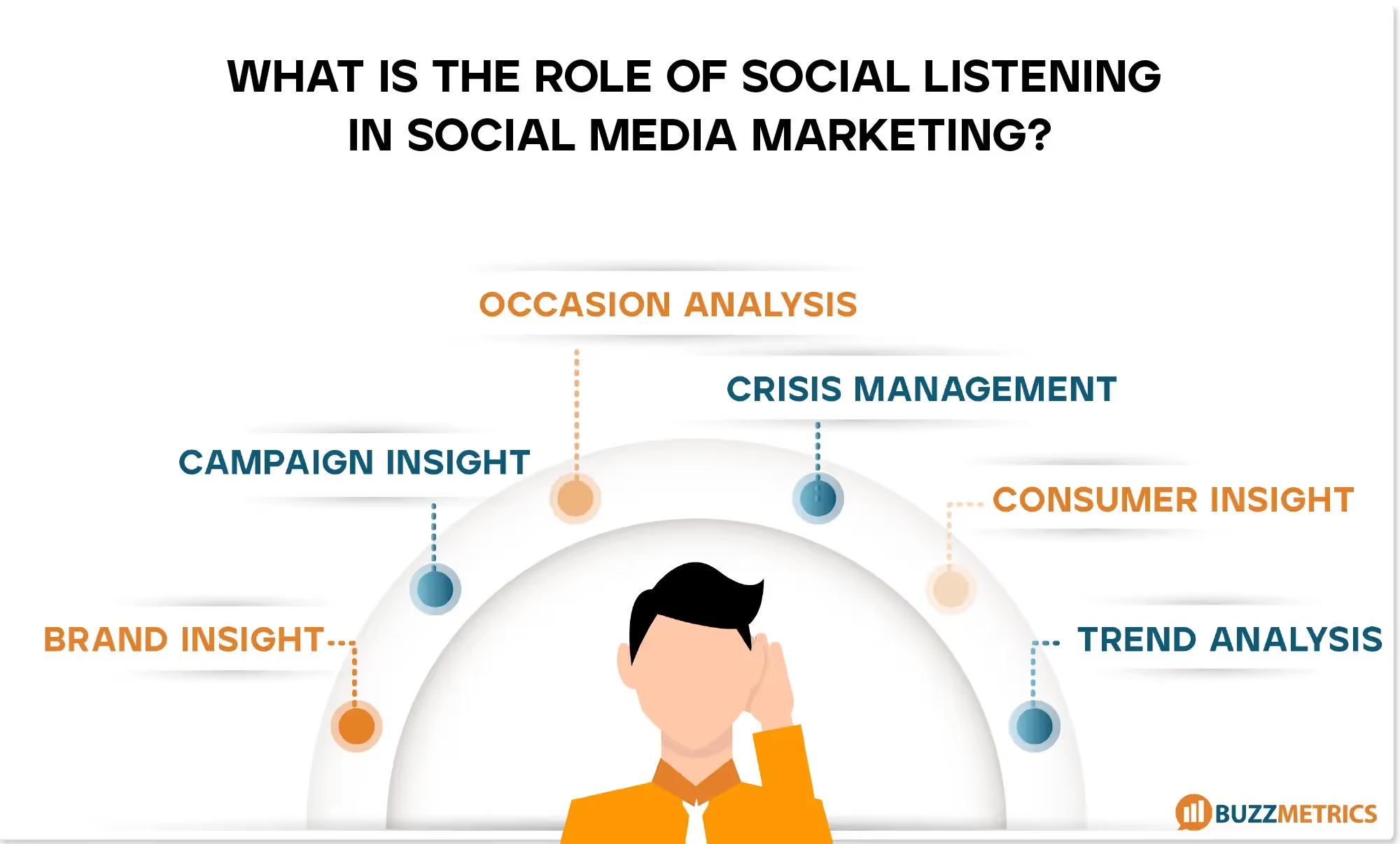
(A) API Data Collection
This method connects Social Listening tools to the APIs (Application Programming Interfaces) of social networks to retrieve posts containing specific keywords.
- Advantages: Allows access to all data from the network, including personal pages.
- Disadvantages: API reliability may fluctuate, leading to incomplete or inconsistent data over time.
(B) Site Data Collection
This method involves accessing listed sites to collect data without disrupting the websites, either by manual or automatic data gathering processes.
- Advantages: Ensures 100% of data on the site is collected.
- Disadvantages: Certain issues, like site changes or blocking, may cause temporary data shortages.
When conducting research via Social Listening, marketers should focus on key metrics to gain a comprehensive view of the research landscape and measure the effectiveness of their Social Media Marketing strategies:
- Buzz Volume: The number of discussions (posts, comments, or shares) about a specific topic.
- Share of Voice (SOV): Compares the discussion volume of a brand against competitors.
- Audience Scale: The number of individuals participating in discussions about a topic.
- Sentiment Score: Indicates users' emotions toward a topic, calculated by comparing positive and negative discussions.
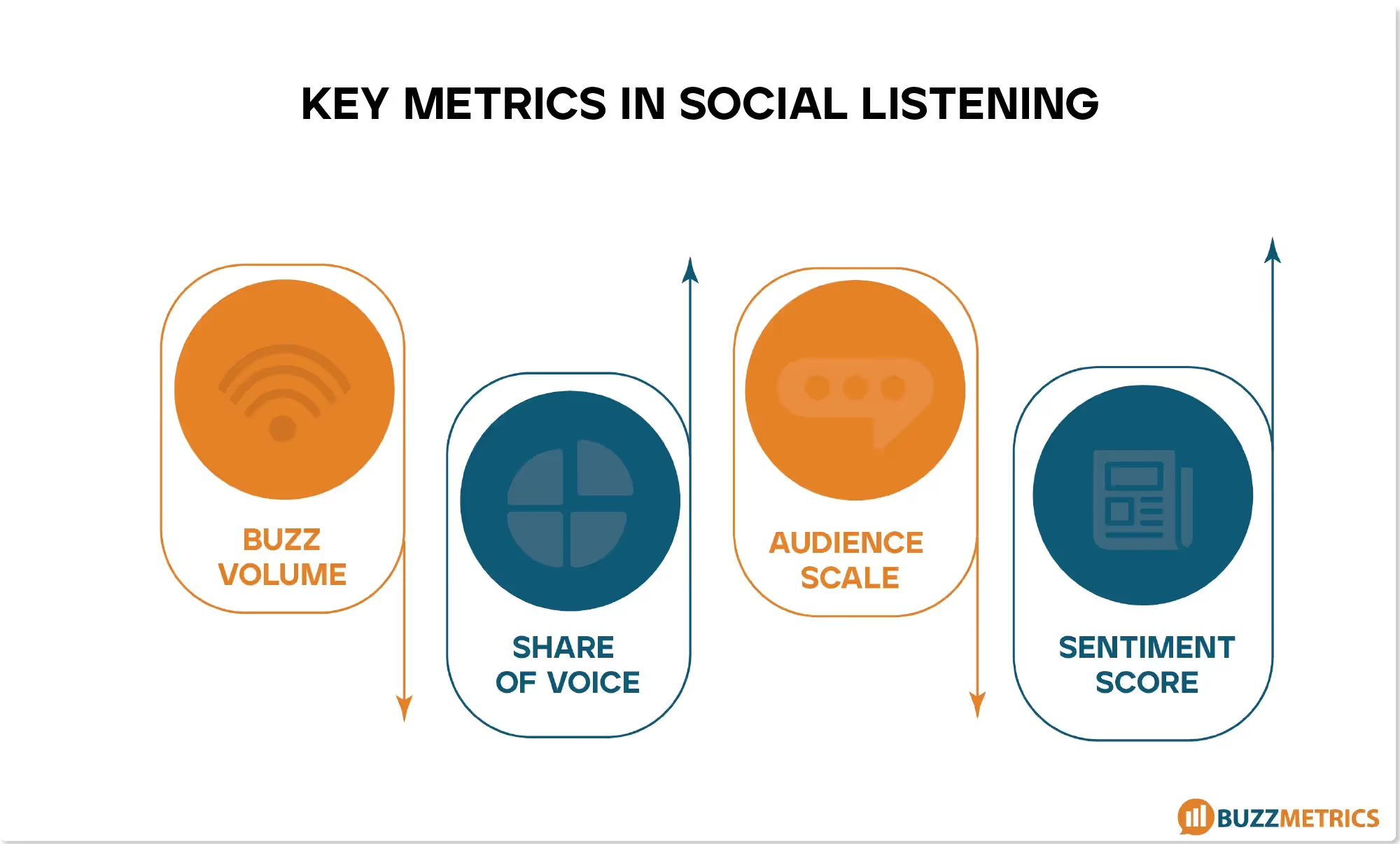
Initially, Social Listening was seen by many marketers as a purely measurement tool, providing basic metrics about campaigns or brands in comparison with competitors (such as discussion volume, participant count, sentiment scores, etc.). However, over time, social media has expanded significantly in scale. Users have become more familiar with Digital Transformation, sharing more than ever, and social media trends are emerging increasingly. As a result, the scope of social media data has broadened, offering a wealth of potential information to support Social Media Marketing strategies. Consequently, Social Listening has also evolved to gather data across various platforms and meet diverse research needs from marketers.
For each research focus, marketers can apply Social Listening to a range of different areas. Typically, marketers can use Social Listening for three main research directions: (1) Insight Understanding, (2) Campaign Tracking, (3) Crisis Management.
This research can provide a comprehensive overview of a specific industry, including e-commerce performance, brand image identification, and opportunities for differentiation. It also outlines the target audience's profile, capturing public attitudes and usage toward products/brands/industries.
a. Industry Competitive Landscape:
For instance, the chart below shows the most-discussed functional food brands over a certain period. From this, brands can identify their competitors, understand their position in the competitive landscape, and aim for top-of-mind awareness among consumers. Moreover, by quoting user discussions, researchers can pinpoint issues regarding public perception of both the brand and its competitors. This allows the brand to compare, recognize problems, and take corrective action if needed.
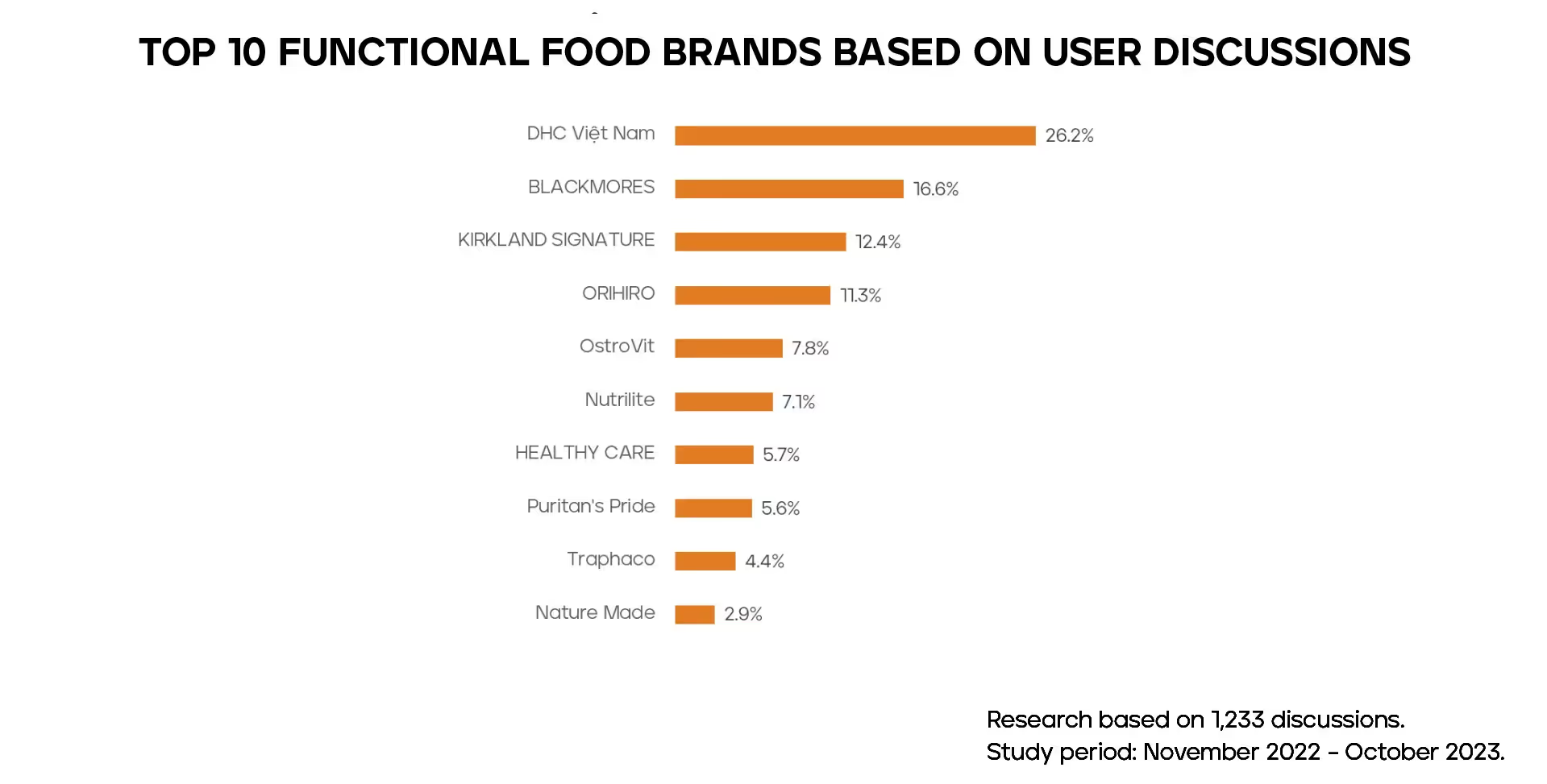
→ Read more: Exploring Insights in the Functional Food Industry: Challenges and Opportunities in the Digital Era
b. Brand Image and Differentiation:
An example of Buzzmetrics research on leading diaper brands paints a detailed picture of brand differentiation. Compared to other brands, Molfix’s product performs exceptionally well in absorbency. However, aspects like softness and thinness received negative feedback. Molfix’s branding team can also monitor current customer perceptions of competitors and identify areas for improvement.
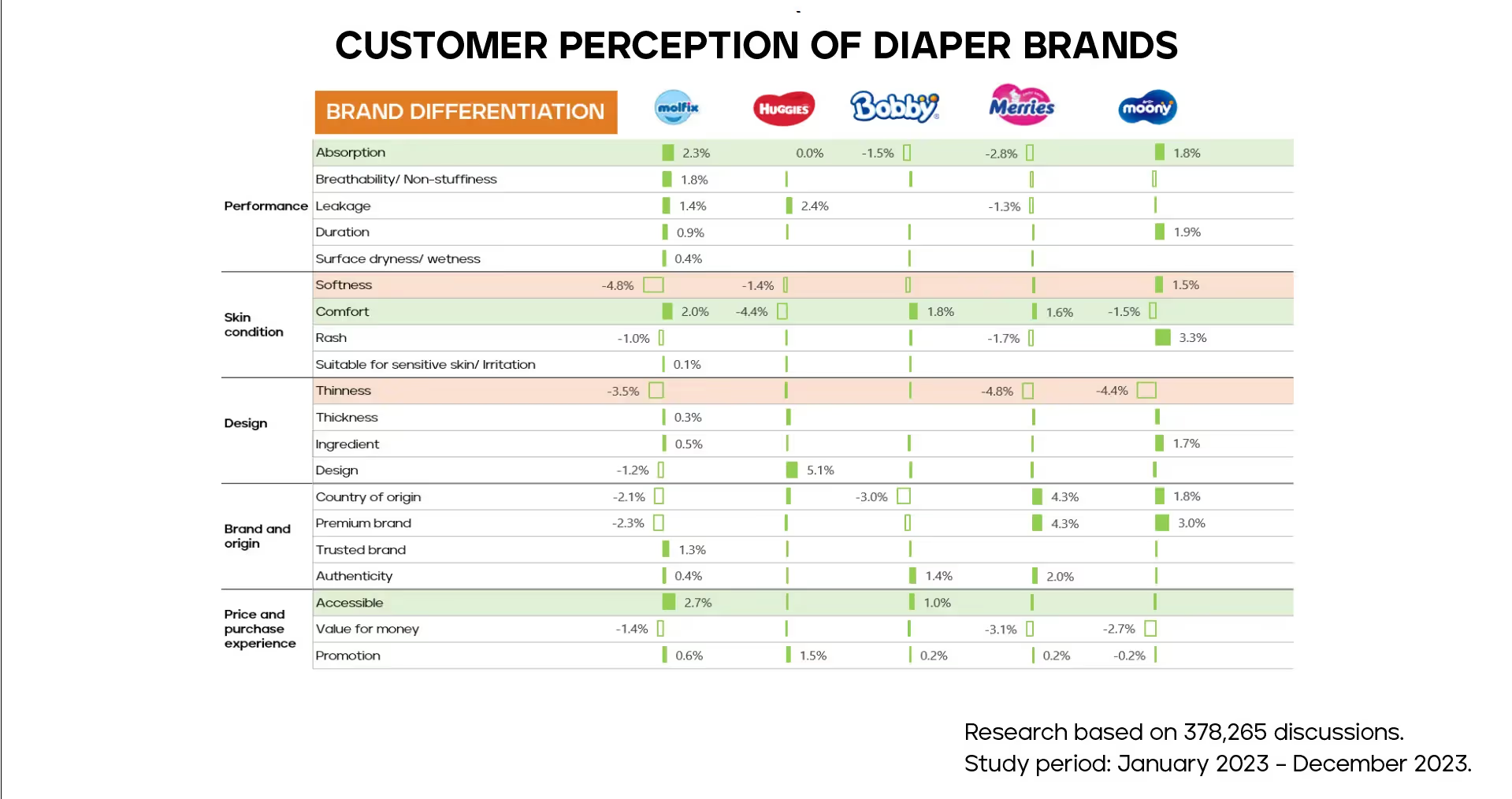
c. Usage and Attitude Research (UnA):
UnA research focuses on consumer discussions and plays a key role in unveiling the consumer landscape of an industry. It addresses key questions like:
- Users' interest levels in the product/brand on social media
- Awareness, usage, and consumer behavior displayed on social platforms
- Motivations and barriers to product/brand consumption
- General satisfaction/dissatisfaction with current products/services
- Users’ needs, unmet demands, or general expectations
d. Target Audience Segmentation:
In some cases, brands aim to understand consumers not just from a product buyer perspective but from a broader context that includes their lifestyle and habits. Social Listening can support brands in achieving this.
For instance, analyzing the most-discussed topics within Gen Alpha revealed that "love" was the top theme, surpassing even "education" and "games." This insight shows that to engage Gen Alpha, brands should consider using "love" as a central theme to attract attention and foster interaction.

→ Read more: Gen Alpha: What Sets the Next Generation of Consumers Apart?
Notably, social media is segmented by interests. Therefore, identifying user groups and their main concerns is crucial in segmenting the social media audience. Pinpointing key interests and insights will help brands align their marketing tactics with user interests. As a result, branded content and messaging are more likely to appear in users' feeds, capturing attention, generating engagement, fostering recall and affinity, or even leading to user-generated content (UGC) related to the brand.
Social Listening supports marketers in planning, creating content, and adjusting strategies in real time throughout all phases of a campaign. It helps track brand sentiment and ensures campaigns align with audience expectations.
Today, even a small complaint on Facebook can cause significant damage to a brand. As consumers become increasingly familiar with social media, the likelihood of crises occurring rises. Our Social Listening data shows that while the number of crises has decreased as brands take a more proactive role in crisis management, the average scale of a crisis has grown significantly.
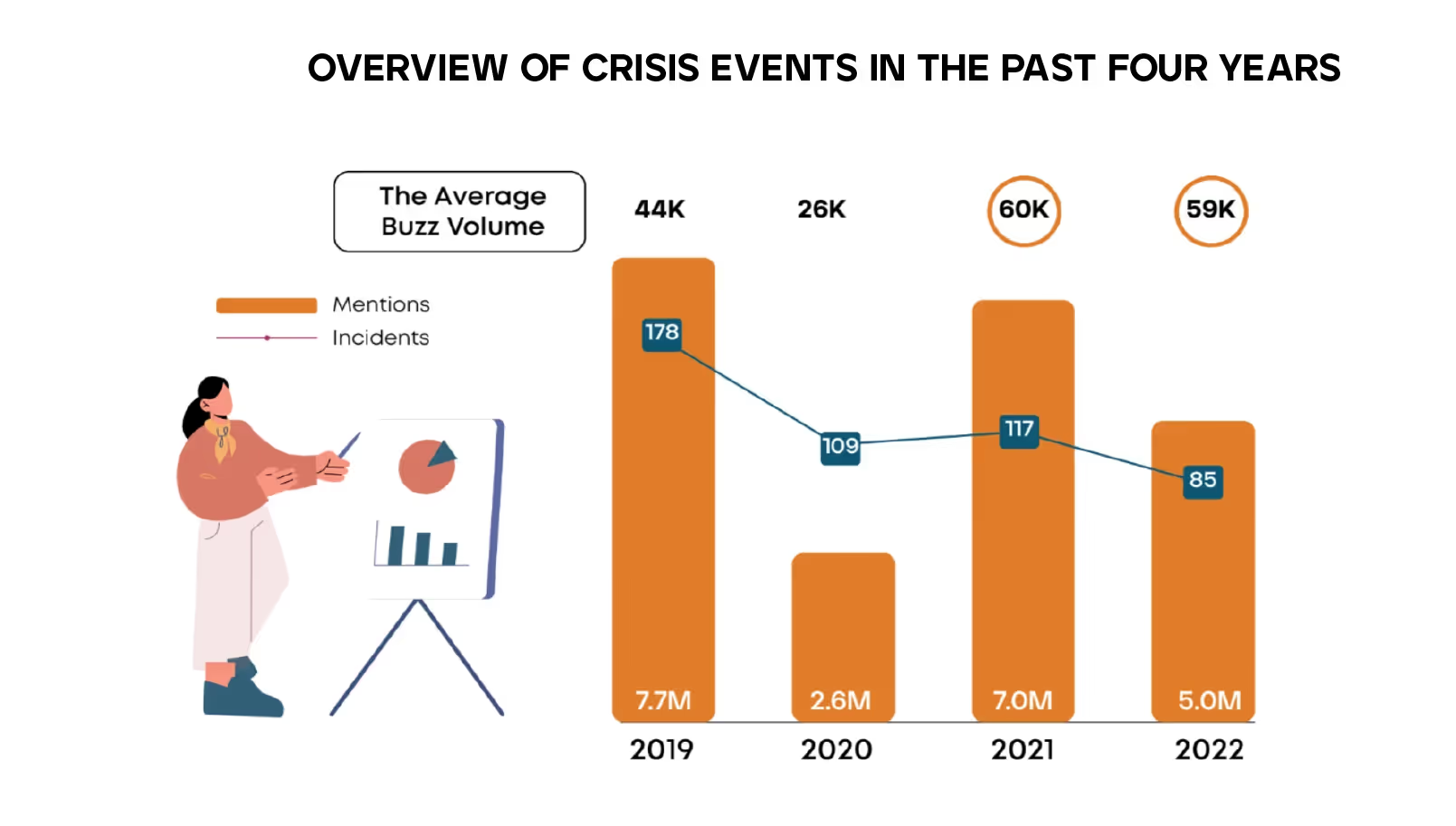
Crises may seem to occur randomly and can impact any brand for seemingly arbitrary reasons. This makes social media crises difficult to track and challenging for brands to respond to. However, through Social Listening, not only can crises be monitored, but their patterns can also be identified, allowing brands to develop strategic response plans.
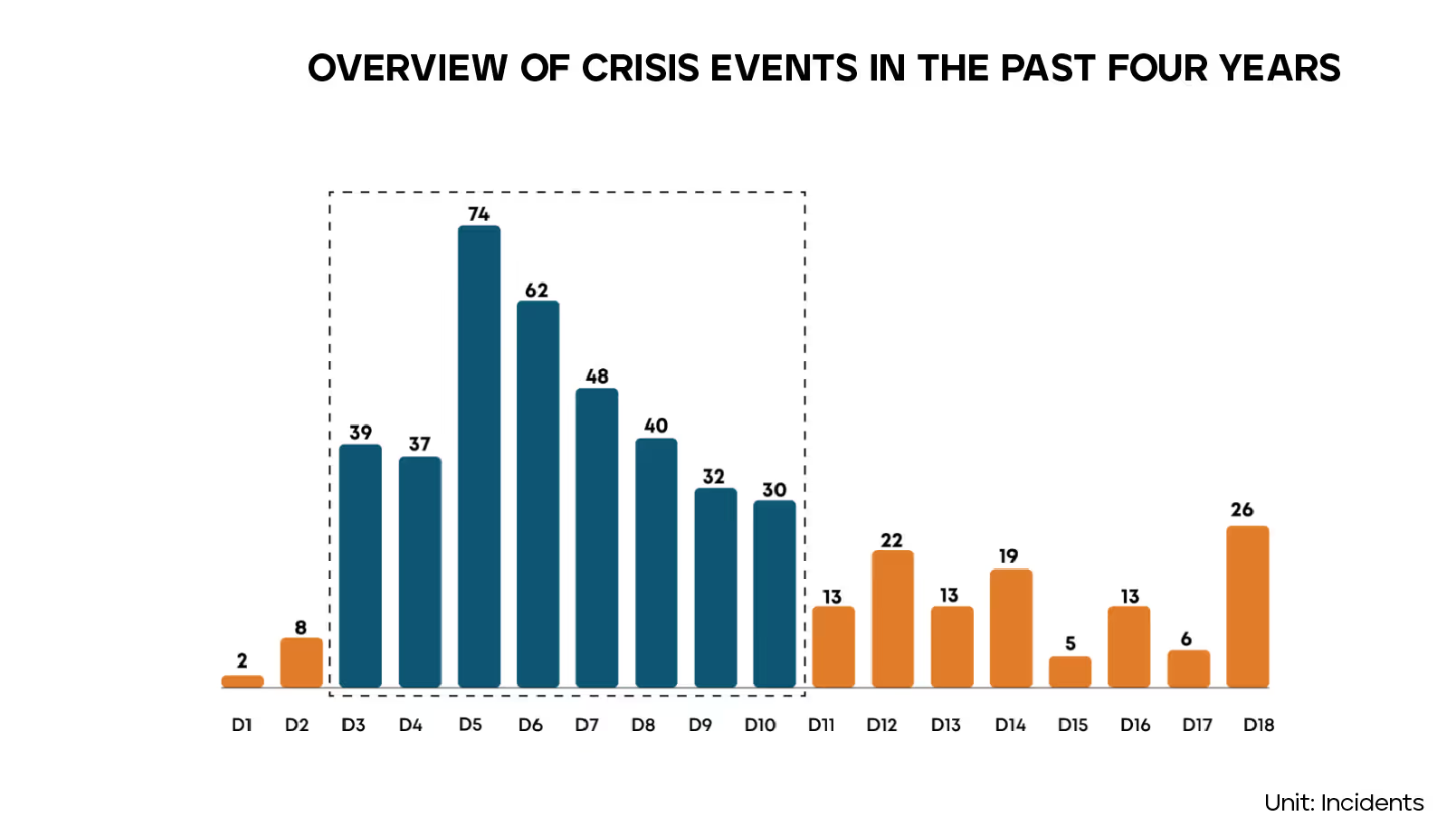
By analyzing user discussions on social media and providing actionable insights to brands, Social Listening plays a critical role in shaping communication strategies. The most common applications of Social Listening include gathering insights, tracking campaign performance, and managing crises.
To learn more about metrics, marketers can refer to here


Social media serves as a massive focus group, capturing real-time consumer opinions. The value of Social Listening lies in analyzing these discussions to uncover valuable consumer insights.
Social media acts as a massive focus group of millions, capturing real-time consumer opinions. The value of Social Listening lies in delving into consumer discussions to uncover key insights. Here’s what Buzzmetrics’ Social Listening can achieve:
Social listening tools, like Buzzmetrics, rely on a large team to analyze all discussions, examining them through the lens of the brand image a company aims to build. This process helps determine if consumers perceive the brand as intended. Based on these insights, brands or agencies can quickly adjust their communication messaging or strategy as needed.

Social listening delivers its true value when research broadens to include entire industries and segments of potential consumers. For example, a formula milk brand would not only focus on discussions about its own brand but also want to understand what expectant mothers care about, such as work stress, family pressure, prenatal care, or the joy of expecting a child. Social listening provides brands with a real view into consumers’ concerns and sentiments, using their own language, allowing the brand to truly connect and support them as a genuine companion.
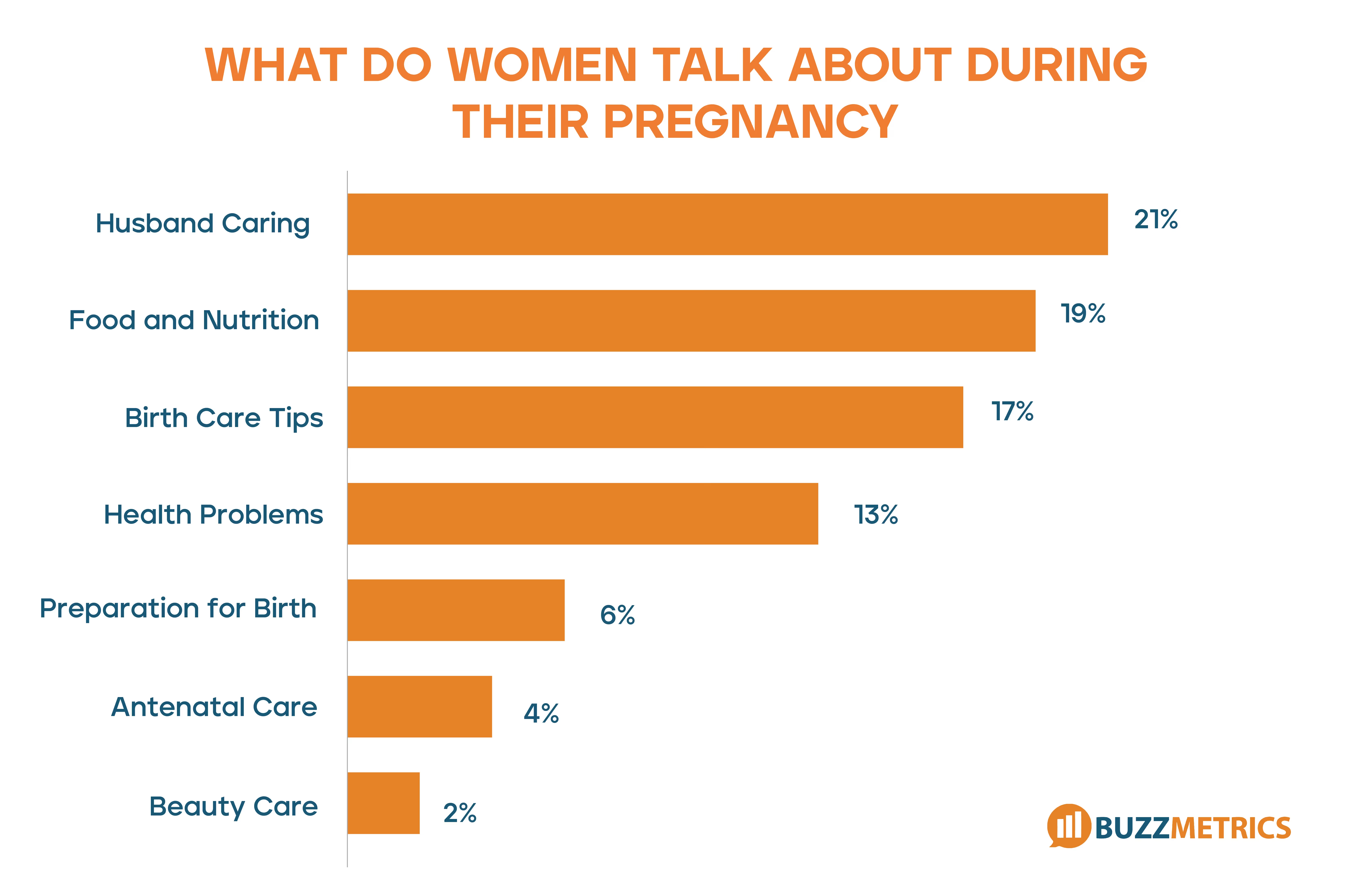
Read more: A case study analyzing discussions in the formula milk industry
When launching a product campaign within an industry, brands need to understand what interests consumers, the factors that drive them to purchase (Drivers of Purchase), what might lead them to stop using a product (Drivers of Defection), and what inspires them to recommend it to others (Drivers of Advocacy). For example, in Buzzmetrics' maternity milk industry report, it was found that mothers value not only the nutritional benefits for their baby but also the ease of drinking. As a result, Anmum has recently emphasized not just nutritional content but also a new image of being “Nutritious for baby, delicious for mom” in its advertising.
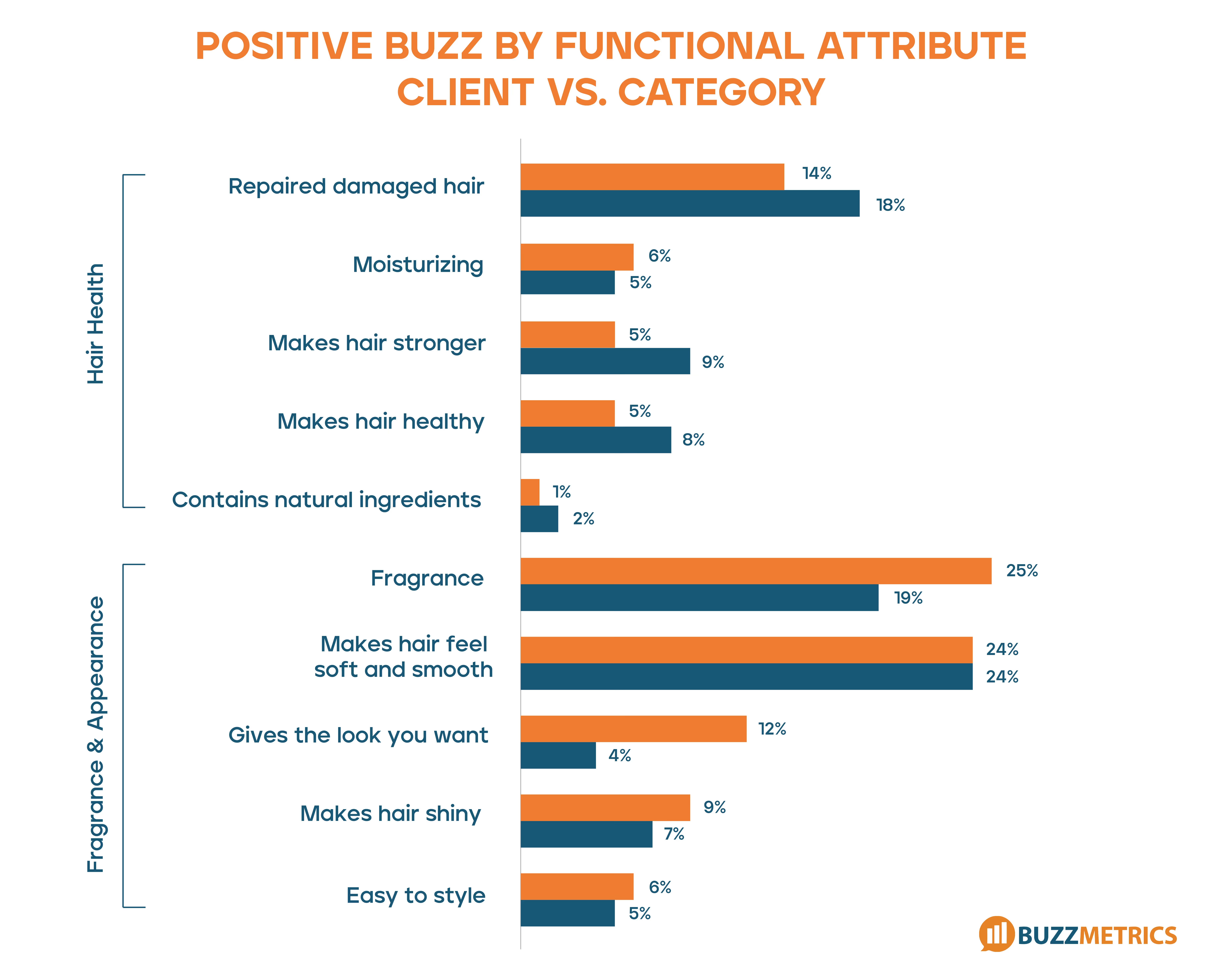
Understanding the Attitudes and Behaviors (Usage and Attitude) of the industry and how competitors are perceived allows brands to develop tailored marketing strategies and set relevant KPIs for agencies. Social listening tools can then directly measure the effectiveness of the agency's campaign execution, providing in-depth insights into its success.
Read more: Social Success Factor – Key KPIs for Social Media Marketing
Buzzmetrics offers crisis monitoring and alert services with extensive data coverage across various platforms, including social media, e-commerce sites, blogs, forums, and other news sources. By collecting data from platforms such as Facebook, TikTok, YouTube, Threads, and e-commerce websites, Buzzmetrics helps brands identify potential crisis signals early. This service not only enables brands to detect emerging negative issues promptly but also provides in-depth analysis to help brands quickly adjust their communication strategies, minimize risks, and protect their reputation. Additionally, Buzzmetrics offers professional crisis management solutions, supporting brands throughout all stages—from detection and monitoring to effective crisis control.
Read more: What lessons can be learned from the automotive industry's communication crisis?


Social Listening can be considered a variant of market research. This method has a reciprocal relationship with traditional market research.
Social Listening can be seen as a variant of market research. Traditional market research has the ability to dive deeper through survey methods, but when conducted on a large scale, it can be costly and time-consuming. Social Listening, on the other hand, involves listening to users on social media, meaning analysis is only possible if consumers share their opinions. However, this method has the advantage of providing real-time results at a lower cost. With the explosion of social media in Vietnam and the rapid growth of Digital Marketing, Social Listening has the advantage of measuring the effectiveness of communication for campaigns and enabling brands to make quick adjustments.f
→ See more: What is Social Listening and how does it play a role in Social Media Marketing?
So, how are Social Listening and Traditional Market Research related, and can Social Listening replace Traditional Market Research? This question will be analyzed from the perspectives of expert analysts at Buzzmetrics, who have experience working at leading research firms such as Nielsen, TNS, and Kantar Millward Brown.
Marketers often question whether the survey methods in traditional market research might yield inaccurate results. Respondents may have a tendency to provide answers that please the interviewer, or their recall could be influenced by recent experiences. On the other hand, while Social Listening captures consumers’ organic opinions, it can be affected by brand seeding activities. This raises an important question: can Social Listening ever produce results that conflict with those of traditional market research?
Over more than 200 Usage and Attitude projects that Buzzmetrics has conducted on social media, the results have largely served to validate and complement traditional market research rather than contradict it. A specific example of the synergy between traditional market research and Social Listening:

Social Listening serves both quantitative and qualitative research purposes. It acts as a massive focus group with millions of participants, offering marketers spontaneous insights into target consumers in the language of the consumers themselves. In several projects Buzzmetrics conducted for FMCG clients, Social Listening was used to identify hypotheses about consumer behavior. The Consumer Market Intelligence (CMI) team then explored these insights further through Focus Groups or Ethnography and finally validated them on a large scale with Quantitative Research.

The limitation of Social Listening lies in the depth of user sharing, which varies across industries. If users do not share their thoughts, Social Listening will not provide insights. In contrast, traditional market research is not constrained by this, as it relies on questioning methods where moderators can guide interviews to uncover the root causes. On the other hand, Social Listening captures consumers’ opinions in the most natural form, unaffected by direct questioning, making it especially valuable for campaign content development and the authenticity of communication messaging.
The Buzz Volume and Share of Voice metrics in Social Listening are often interpreted alongside each other and are closely related to the Awareness metric in Brand Health Tracking. Meanwhile, the Sentiment Index in Social Listening has a direct correlation with Customer Satisfaction Score (CSAT) or Brand Equity Index.
→ Learn more: How do social listening systems measure Sentiment?

Social Listening and Traditional Market Research Complement Each Other Across Brand Phases: From Concept to Launch and Post-Market Launch:

When it is compiled from multiple sources, including social media, where consumers voluntarily share their insights. Additionally, Social Listening has advantages in terms of cost, real-time updates, sample size, and more. Therefore, businesses, marketers, and brands should allocate resources to both methods of market research to achieve the highest effectiveness.
Moreover, brands can also consider using the Ecommerce Audit method to assess the competitive landscape and evaluate the performance of their sales activities on e-commerce platforms. This type of research will help complete the brand’s image on social media, enabling brand managers to make data-driven decisions, avoid falling into the trap of "gut feeling," and take timely actions.
Thus, there exists a mutually supportive relationship between Social Listening and traditional market research. Social Listening fills the information gaps of traditional research methods, especially when faced with limited budget and time constraints.

